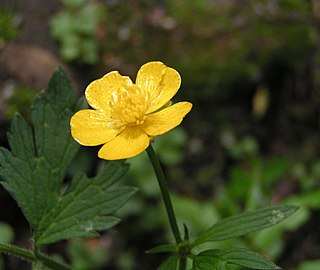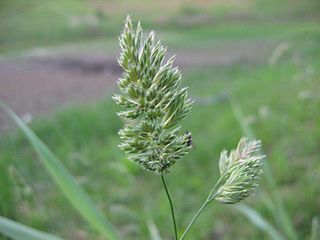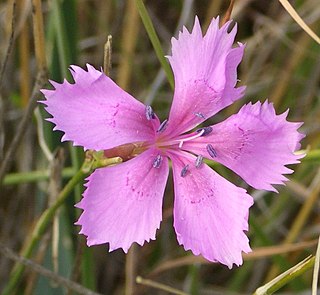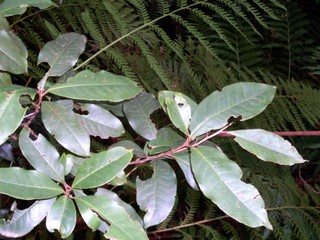
The Ericales are a large and diverse order of dicotyledons. Species in this order have considerable commercial importance including for tea, persimmon, blueberry, kiwifruit, Brazil nuts, argan, cranberry, sapote, and azalea. The order includes trees, bushes, lianas, and herbaceous plants. Together with ordinary autophytic plants, the Ericales include chlorophyll-deficient mycoheterotrophic plants and carnivorous plants.

The Magnoliales are an order of flowering plants. Well-known members of Magnoliales include: magnolias, tulip trees, custard apples, American pawpaw, cherimoyas, ylang-ylang, soursop fruit, and nutmeg.

Theales is a botanical name at the rank of order. Early classifications such as that of Dahlgren placed the Theales in the superorder Theiflorae. The name was used by the Cronquist system for an order placed in subclass Dilleniidae, in the 1981 version of the system the circumscription was:

Ranunculales is an order of flowering plants. Of necessity it contains the family Ranunculaceae, the buttercup family, because the name of the order is based on the name of a genus in that family. Ranunculales belongs to a paraphyletic group known as the basal eudicots. It is the most basal clade in this group; in other words, it is sister to the remaining eudicots. Widely known members include poppies, barberries, hellebores, and buttercups.

Proteales is an order of flowering plants consisting of three families. The Proteales have been recognized by almost all taxonomists.

Burmanniaceae is a family of flowering plants, consisting of 99 species of herbaceous plants in eight genera.

The Angiosperm Phylogeny Group (APG) is an informal international group of systematic botanists who collaborate to establish a consensus on the taxonomy of flowering plants (angiosperms) that reflects new knowledge about plant relationships discovered through phylogenetic studies.

Asphodelaceae is a family of flowering plants in the order Asparagales. Such a family has been recognized by most taxonomists, but the circumscription has varied widely. In its current circumscription in the APG IV system, it includes about 40 genera and 900 known species. The type genus is Asphodelus.

Asparagaceae, known as the asparagus family, is a family of flowering plants, placed in the order Asparagales of the monocots. The family name is based on the edible garden asparagus, Asparagus officinalis. This family includes both common garden plants as well as common houseplants. The garden plants include asparagus, yucca, bluebell, and hosta, and the houseplants include snake plant, corn cane, spider plant, and plumosus fern.
Plant taxonomy is the science that finds, identifies, describes, classifies, and names plants. It is one of the main branches of taxonomy.
The APG system of plant classification is the first version of a modern, mostly molecular-based, system of plant taxonomy. Published in 1998 by the Angiosperm Phylogeny Group, it was replaced by the improved APG II in 2003, APG III system in 2009 and APG IV system in 2016.
The APG II system of plant classification is the second, now obsolete, version of a modern, mostly molecular-based, system of plant taxonomy that was published in April 2003 by the Angiosperm Phylogeny Group. It was a revision of the first APG system, published in 1998, and was superseded in 2009 by a further revision, the APG III system.

In plant taxonomy, commelinids is a clade of flowering plants within the monocots, distinguished by having cell walls containing ferulic acid. Well-known commelinids include palms and relatives, dayflowers, spiderworts, kangaroo paws, and water hyacinth, grasses, bromeliads, rushes, and sedges, and ginger, cardamom, turmeric, galangal, bananas, plantains, and bird of paradise flower.

The Balanophoraceae are a subtropical to tropical family of obligate parasitic flowering plants, notable for their unusual development and formerly obscure affinities. In the broadest circumscription, the family consists of 16 genera. Alternatively, three genera may be split off into the segregate family Mystropetalaceae.

Caryophyllales is a diverse and heterogeneous order of flowering plants that includes the cacti, carnations, amaranths, ice plants, beets, and many carnivorous plants. Many members are succulent, having fleshy stems or leaves. The betalain pigments are unique in plants of this order and occur in all its core families with the exception of Caryophyllaceae and Molluginaceae. Noncore families, such as Nepenthaceae, instead produce anthocyanins.

The Paracryphiaceae are a family of woody shrubs and trees native to Australia, southeast Asia, and New Caledonia. In the APG III system of 2009, the family is placed in its own order, Paracryphiales, in the campanulid clade of the asterids. In the earlier APG II system, the family was unplaced as to order and included only Paracryphia.

The Torricelliaceae are a family of trees native to Madagascar and southwest Asia. It contains three genera, Aralidium, Melanophylla and Torricellia. Under the APG II system, each of these genera was placed in its own family, but with the proviso that "Some of the families are monogeneric and could possibly be merged when well-supported sister-group relationships have been established." Such a relationship was established for these three genera in 2004. In the APG III system, these three genera constitute the family Torricelliaceae.
The APG III system of flowering plant classification is the third version of a modern, mostly molecular-based, system of plant taxonomy being developed by the Angiosperm Phylogeny Group (APG). Published in 2009, it was superseded in 2016 by a further revision, the APG IV system.

Pelliciera rhizophorae, known as the tea mangrove, is a less-common species of mangroves found along the Pacific coast from the Gulf of Nicoya in Costa Rica to the Esmeraldas River in Ecuador, as well as within stands located in Nicaragua, Panama, and Colombia. During eras such as the Cenozoic, the species was prevalent. The mangrove hummingbirds of Costa Rica live off the relatively large quantity of nectar produced by its prolific blooms. Pelliciera rhizophorae is the only species in the genus Pelliciera which was previously recognized as the only genus in the family Pellicieraceae, but is now included in the family Tetrameristaceae.

The APG IV system of flowering plant classification is the fourth version of a modern, mostly molecular-based, system of plant taxonomy for flowering plants (angiosperms) being developed by the Angiosperm Phylogeny Group (APG). It was published in 2016, seven years after its predecessor the APG III system was published in 2009, and 18 years after the first APG system was published in 1998. In 2009, a linear arrangement of the system was published separately; the APG IV paper includes such an arrangement, cross-referenced to the 2009 one.















